With Ben Affleck’s major motion picture on the way, Boardroom spoke to former Nike execs to break down the business behind MJ’s first Swoosh shoe.
On Super Bowl Sunday, famed film franchises rolled out the red carpet for trailers, teasing more movie sequels to come.
Indiana Jones 5. Scream 6. Transformers 7. The Fast & the Furious 10.
While a litany of cinematic series are investing in yet another victory lap, Ben Affleck’s upcoming AIR preview broke the trend of stacking superhero hoopla and car cachet with that of a new story that still proves old in origin.
Playing rebel Nike founder Phil Knight, AIR tells the real-life story behind the Beaverton brand going all-in on a pro hoop prospect named Mike Jordan.
In the two-minute trailer, the famous Air Jordan 1 is seen in its storied “Chicago” glory. Along the way, sketches on another pair are previewed: the Nike Air Ship.
As history tells it, the tight turnaround between signing MJ to the Swoosh to having a signature sneaker ready for the NBA hardwood — let alone market — was almost as impossible as making the deal go down in the first place.
To learn the origin of the mysterious sneakers made for Jordan as a test mule and placeholder before the OG Air Jordan arrived, Boardroom sat down last summer with a group of former Nike execs, known collectively as the 6453ers.
Read on to get the inside scoop on the prequel to basketball’s billion-dollar brand.
Prepare for Liftoff
At 21 years old, Michael Jordan only had one nickname: Mike.
Dubbed “Magic Mike” for his love for Earvin “Magic” Johnson, the term ‘Air’ only applied to biology courses where he was concerned.
Over the course of the late ’70s and early ’80s, a sportswear startup named Nike tried to change the notion of ‘Air,’ rebranding the earth’s atmosphere as a performance innovation.
First, it was encapsulated in the Air Tailwind — an early entry from the brand’s running range. Years later in 1982, it appeared in the pivotal Air Force 1 basketball shoe. Designed by Bruce Kilgore in a hiking boot’s image, the AF1 aimed to orient Nike’s hardwood line with sci-fi flair.
It was a Hail Mary for Nike, which attracted talent like Spencer Haywood, but couldn’t compete with Adidas or Converse.
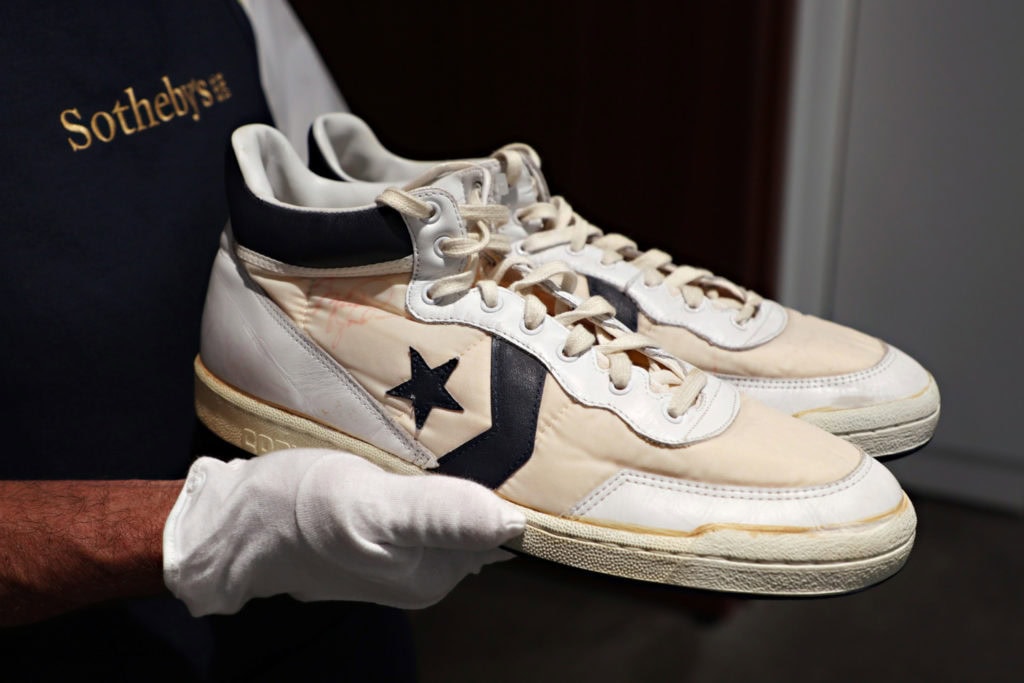
“In 1979, 80 to 90% of our sales were running shoes,” Brad Johnson, former Head of Category at Nike Basketball, told Boardroom. “In ’82, Converse was the authentic basketball shoe.”
With the Air Force 1, Nike could convince college coaches that it was on the cutting edge of basketball’s best. By using Air technology, Nike was saving the legs of their revered recruits.
Ideally, this same selling point would work on consumers.
“We were trying to use innovation as a point of differentiation,” Johnson said. “We believed in Air, but there was skepticism from athletes who’d been playing since they were kids in Pro-Keds or Converse with zero cushioning.”
For consecutive seasons, the Air Force 1 was the top-tier product offered to Nike schools such as Syracuse, St. John’s, and Maryland.
While prized players like Pearl Washington, Len Bias, and Mark Jackson were turning heads in Swoosh-stamped sneakers, young Mike Jordan was loyal to Converse on-court.
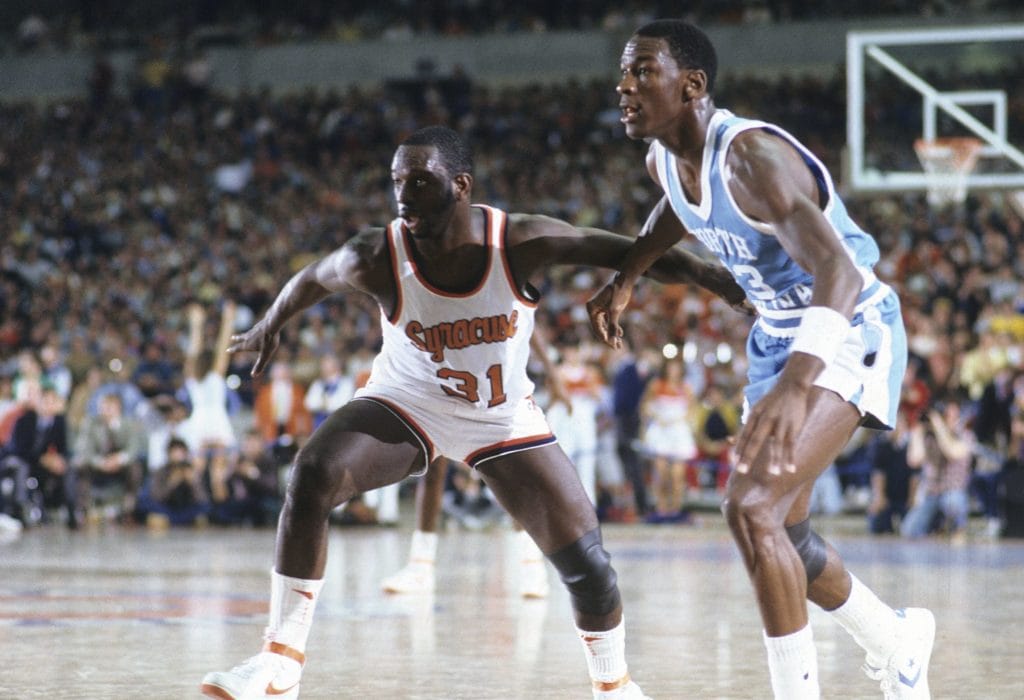
Even worse for the brand in Beaverton? He was absolutely in love with Adidas off the court. Nevertheless, he was Nike’s No. 1 target.
Possessing the ‘it’ factor that only Swoosh salesman Sonny Vaccaro could see, Nike made MJ a $500,000 offer in the summer of ’84. The selling point was not only a huge contract but also in pitching his parents on being the brand’s first signature basketball athlete.
This meant commercial campaigns and a royalty for each shoe sold.
Mike’s ability to fly on-court aligned with their Air innovation, resulting in a marketing match made in heaven.
Persuaded by his parents, MJ signed the deal and Nike had its man.
The only problem? It didn’t have any shoes for him.
Cobbled Cargo
After leading Bobby Knight’s Team USA squad to a gold medal, Mike inked an unprecedented endorsement deal with the Swoosh.
Miles away from the Windy City in the brand’s Beaverton offices, execs were ecstatic. They were also in over their heads.
“We signed Michael right after the ’84 Olympics,” Johnson said. “The season was starting in the fall and we needed some shoes for him. Peter Moore had designed the [Air Jordan 1] and we decided he was going to be the first quasi-signature athlete.”
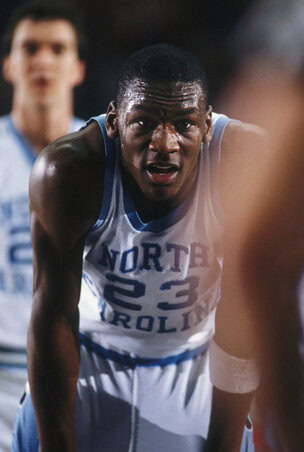
As alluded to, Mike’s signature shoe was in the works as soon as he signed his signature on the contract.
Though the brand pulled out all the stops to rush production, Mike barely knew the brand and the brand barely knew him.
“At that point in time, we were just being introduced to Michael,” said Johnson.
“He had always played in Converse. We were trying to convince him on Air and whether or not we should call it the ‘Air Jordan.’ Everything was happening at hyper-speed because we signed him at the end of August and he was going to play in October!”
For Mike to truly be “Air Jordan” both in image and on foot, he had to trust the brand’s Air technology.
While the proper Air Jordan 1 was still being workshopped overseas, the successor to the Air Force 1 — the Nike Air Ship — was already in production. With this unassuming team shoe, Nike could convince MJ that Air cushioning was both the future and his future.
However, like any elite athlete, MJ was both stubborn and specific.
His player-exclusive iterations of the Air Ship were to be cut shorter than the high-top retail renditions — effectively making them a mid — while the trademark technology was also under review.
Entering the NBA, MJ’s athleticism was the sole catalyst for his elite two-way play. To be able to cut quickly on offense and defense, he needed to feel the floor.
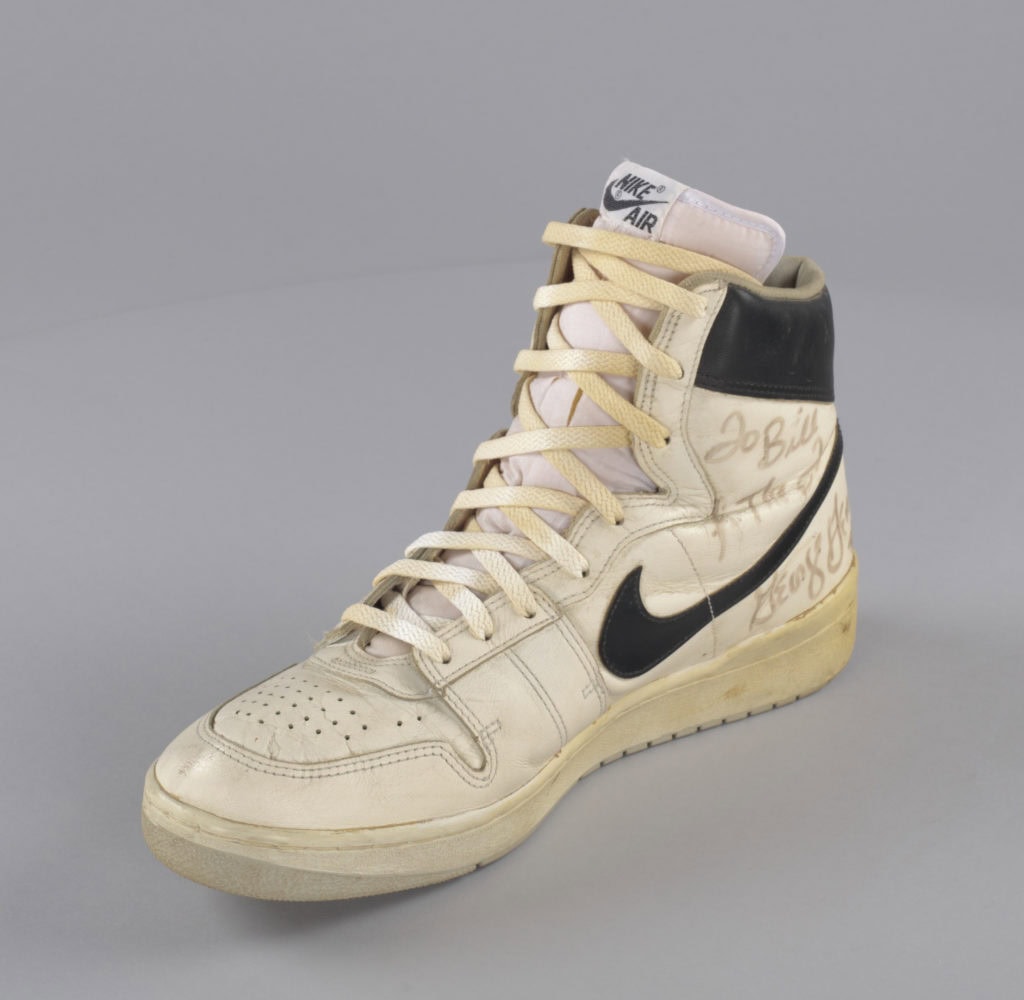
To him, and many other endorsers, Air was not a proponent of performance but rather an obstacle.
“There’s natural skepticism to new technology in any market,” Kirk Richardson, the man who served as a footwear therapist to the original Air Force 1, told Boardroom. “Air had significant performance benefits that we just needed time to explain.”
That explaining had to take place in real-time during the first weeks of Bulls training camp.
Sometimes, money talks louder than science.
“We were spending about $7 million then,” Richardson says. “Probably about $35 million by today’s standards. And we were getting continual bombardment from the lab saying, ‘Why the F are you not using this technology in all your shoes?!'”
Back in Beaverton, brand brass rushed to ready shoes for MJ. They spent their time calling factories in Asia while checking on insights from the Sports Research Lab in Exeter.
Operating around the clock in three time zones, the Nike Air Ship was cobbled into two technical promo pairs for MJ to test.
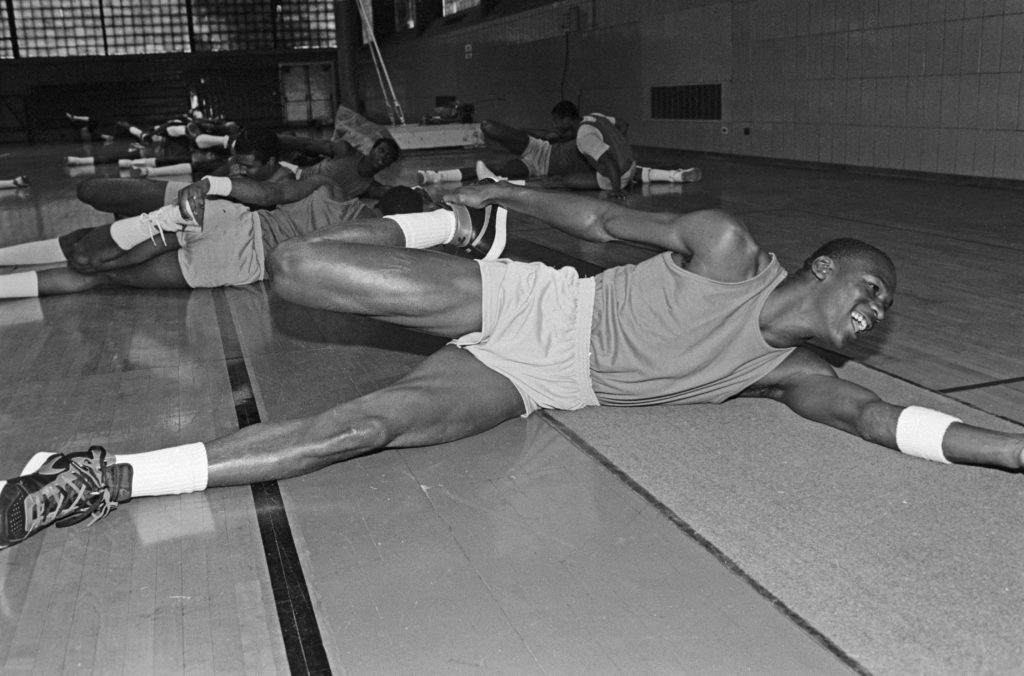
Famously, the first one was a bold black and red mid-top made with tooling from a tennis shoe.
The mismatching upper was to distinguish the rebellious rookie from his Chicago comrades. The cushioning was akin to something John McEnroe would serve aces in.
“The Black/Red PE had a Pro Circuit bottom,” Tom Amedeo, InStyleShoes owner, told Boardroom. “Whereas a week later, his Air Ship had an Air Jordan 1 bottom.”
Key context: A week later, said shoe not only changed; it disappeared.
In a war of brand leverage and marketing morals, David Stern and Rob Strasser would collide. Inside the NBA, it’d start a civil war that eventually meant more millions for all.
No Fly Zone
Where photographic evidence is concerned, Jordan only wore the Black/Red Nike Air Ship PE in public twice. First, at Chicago Bulls training camp, then in an exhibition game against the New York Knicks.
The latter instance caught the eye of young NBA commissioner David Stern, who while keen on selling star power and individuality, was also a stickler for rules.
By wearing Black/Red sneakers in contrast to the White/Red renditions of his teammates, Jordan violated the league’s dress code.
Despite investing $500,000 in MJ to make him stand out, continuing to do so would be a bridge too far for Phil Knight and the company’s collective bank accounts.
“David Stern called and said, ‘We’re fining him $1,000,'” Johnson said.
“Rob Strasser said, ‘Great, we’re going to send you a check for $82,000 because he’s going to wear them every game.’ Stern said, ‘It doesn’t work like that. It’s $1,000, $5,000, then $10,000, then we’ll suspend him.'”
So Nike execs got back on the phone with factories in Asia and the Sports Research Lab in Exeter.
The result was an adjusted PE pair made in league-friendly tones with what would become the eventual outsole for the Air Jordan 1.
“The White/Red pair was like test mules,” Russ Bengtson, author and former editor at SLAM and Complex, told Boardroom. “It was a lower cut with a lower profile sole.”
For the remainder of the exhibition outings and into the regular season, MJ began to fly in the white-based Air Ship PEs.
It was an early entry to Air for the man set to become Air Jordan — even though that promo pair and the Air Jordan 1 featured very little Air.
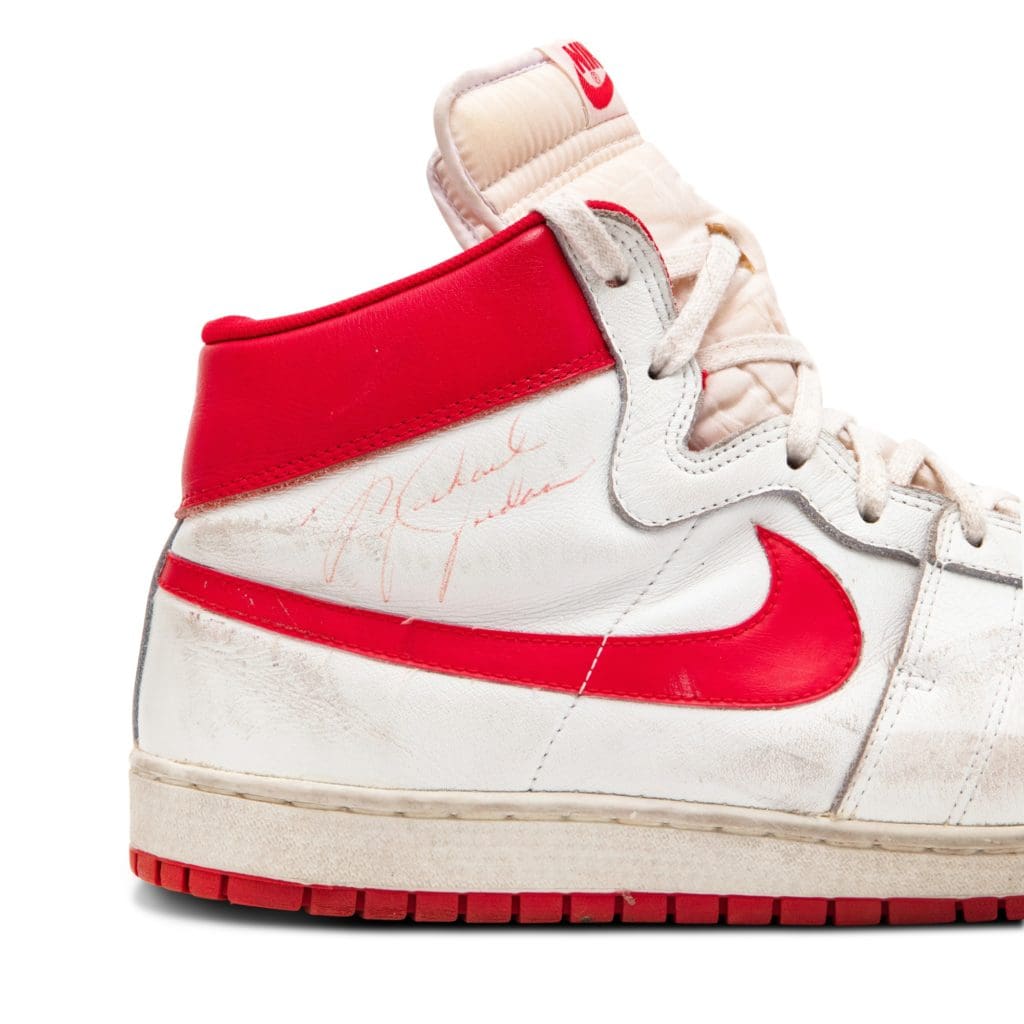
In reality, the latter Air Ship PE and retail renditions of the Air Jordan 1 feature a heel Air unit roughly the size of a potato chip.
After a fractured foot in his second season, the brand sold him on its trademark innovation, realized by the lofty Air Jordan 2.
Still, it was the Air Ship that ushered in the Air Jordan era. It served as a placeholder for the brand’s biggest basketball investment.
“Originally, we wanted to have him in the Air Ship because we didn’t think we could get a shoe to market,” Johnson said. “He was the test athlete. Which was fantastic because he signed this huge $500,000 contract and we had to get him in some shoes.”
In due time, that investment would pay off for all involved.
Commercial Flight
It only took Michael Jordan nine games to score 45 points in an NBA outing.
Instantaneously, he was a fan favorite with every kid in Chicago looking to get his sneakers.
The problem for Nike? The Air Jordan 1 wouldn’t be ready for retail until April 1985.
Furthermore, Nike marketed the Air Ship as a team shoe and sold it mostly to college and high school programs.

If fans wanted an ‘Air Jordan’ sneaker in 1984, they had to take them off Mike’s feet.
As expected, they did.
“When you talk about Jordan, we’d make him 18 pairs of shoes,” Johnson said.
“He started signing them and giving them away. We thought 18 pairs would last him a whole season. For him, it lasted 18 games! He changed that game. Because none of the other athletes were that popular.”
Popularity had its perils … and its pluses.
Shortly after the 1985 NBA All-Star Game — one in which Jordan started as a rookie — the Air Jordan 1 was a fixture on MJ’s feet and almost ready for retail.
Just in time for the playoffs, the Air Jordan 1 hit select stores, then eventually malls all over America.
In a matter of months, the Air Jordan range did $55 million in sales.
The big bet placed by Phil Knight and Sonny Vaccaro — set to be told cinematically in AIR — was worth 10x its weight in gold.
The trademark technology had been validated by basketball’s supreme superhero, changing the future of Nike forever. Moreover, it influenced just how hoop shoes connected through culture in regard to fashion and fandom.
“At that point, basketball was not a street shoe,” Ron Hill, former Nike Product Merchandiser, told Boardroom. “It was a basketball shoe first, second, and third. But that eventually started to change.”
While the Air Jordan 1 changed the course of history in style and sales, the Air Ship started it all behind the scenes.
Less loved but ultimately important, it’s a forgotten favorite that just happened to be in the right place at the right time.
“It’s what we had until we had Air Jordan shoes,” said Hill.